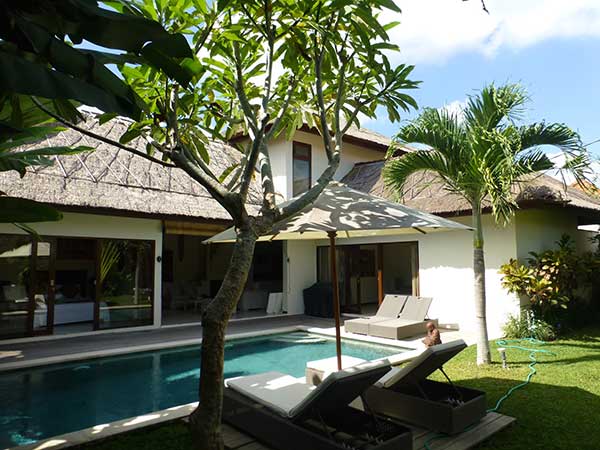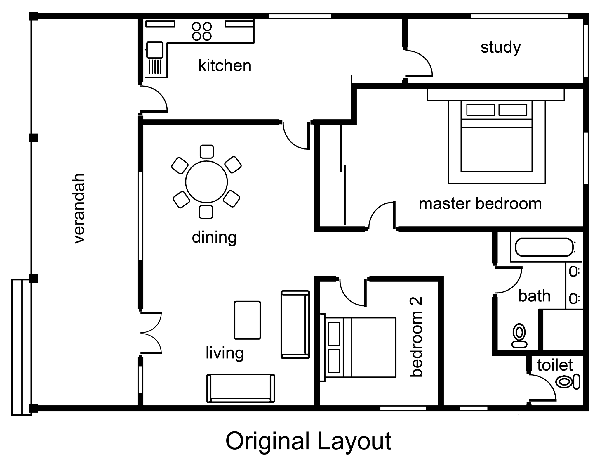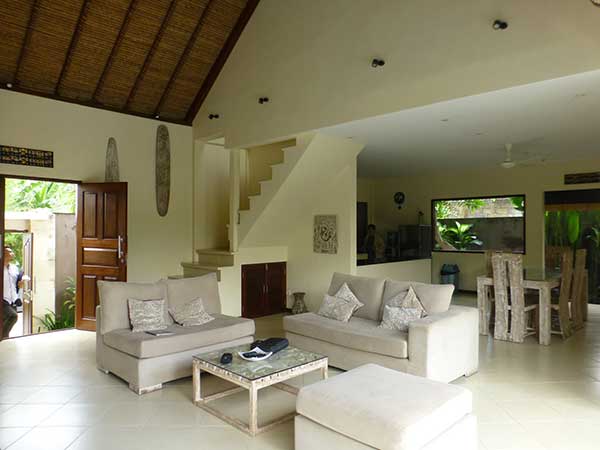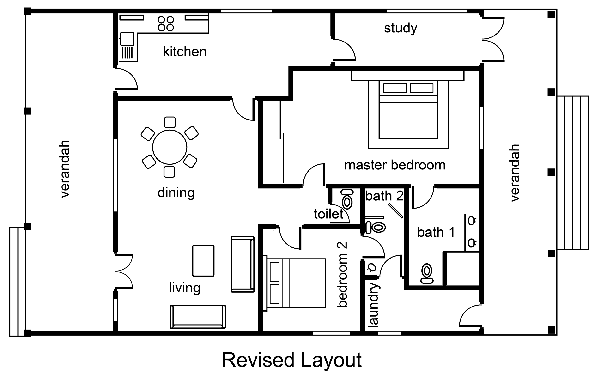Remodelling Your House

How to remodel a house layout
The layout of a house does not always suit the lifestyle of the people who live in it. An architect designs a house as well as he/she can but, after living in the house for some time, the owner(s) may often think of ways that the design and layout can be improved to more closely suit their lifestyle. The owners may have changed or the owner's circumstances may have changed. Here we look at remodelling your house, some basic principles to consider and a typical example of improving the layout of an existing house. How to make the most of the space and how to increase the value of your home.
For further information see:
- Renovating Tired and Scruffy Buildings
- A Strategic Approach to Renovation
- Planning a Building Renovation
- Mr Fixit Renovation Services
Renovation or Remodelling?
In other articles we talked about building renovation, a process usually carried out when a building starts to look tired or dated. Renovation may involve anything from simply a new coat of paint, new tiling, upgrading toilets and bathrooms, perhaps an additional window or even a new roof. Renovation basically involves repairing and redecorating.
When people buy an existing property, however, they often find that while they like the property (well you would hope they would) all too often there is something about the layout that doesn't suit them.
The architects that design our houses are not totally infallible and in their push to create some artistic masterpiece can sometimes fail to understand the logistics of how ordinary people do ordinary things like eating, sleeping, washing, undressing, cooking and going to the tut. We may need to modify the layout of the house, to remodel it..
House remodelling example - a splendid house but with some serious layout problems
Let us take as an example a splendid house set in ricefields in a beautiful corner of Bali. A nice square house built on a large piece of land with well established gardens. The house is well built and beautifully finished with stone cladding on the outside walls.
But there was a problem. The new owners realised that there were aspects about the internal layout that simply didn't work. Here is the house's original layout:

As you see it has a nice verandah to the front, a comfortable living / dining room and an ample kitchen with a splendid view out over rice fields to the North. But you will also note that right through the centre of the house was a corridor. It was a magnificent corridor, wide and long, that lent an air of magnificence and importance to the house. After 3 kilometres and a couple of right angle bends the importance ended in impotence as a final doorway lead to a small guest toilet hidden at the back corner of the house. The hallway to nowhere was a huge area of totally dead wasted space. Clearly this was an architect that shouldn't have given up his day job recycling cigarette buts.
In addition as a living space the house had major issues with only one bathroom shared between two bedrooms and with the only access being via that huge corridor. No crawling out of bed in the buff for a quick widdle in the middle of the night in this house. That wonderful early morning freedom of hanging free while pottering between bedroom and bathroom as you prepare for your day. Going to the lav was an expedition requiring the donning of formal attire to remain decent should you bump into Aunty Dorothy in the middle of the night.
You will also note that the only entrances to this building were both on the front of the house which faces away from the back garden. The back garden incidentally is the nicest aspect of the property. As it happens there is a two bedroom guesthouse in this back garden so there was a total disconnect between the two buildings.
Traditional house layout
Until only a couple of generations ago house floor plans tended to follow standard designs that had evolved over centuries. A front door would lead into a porch or directly into a hallway, a corridor, which would run down the centre or one side of the house. The parlour or sitting room would be at the front, living room in the centre and the kitchen at the back. Bedrooms might be upstairs or further down the hall. Different periods of history had their own variations but usually followed this general concept.

The removal of walls eliminates dead space
In the 1960s things changed dramatically. House designs became far more creative and as a result more varied and open plan in nature.
It was realised that a hallway is dead space and very expensive in terms of the walls they require (to be decorated both sides) and with more doorways than the Queen Mary. The hallway was all but done away with and the living and dining rooms provided the passageway through the house - a far more efficient arrangement. Only in the bedroom areas were hallways retained where access to rooms was required while still maintaining privacy. All across the world hallway walls were removed.
Traditional Balinese Design
Here in Bali things are quite different. A traditional house here is usually in the form of a compound with a series of separate buildings each having their own predesignated purpose and position. The family temple closest to Mount Agung and the toilet at the opposite corner with the kitchen next to it. For more information see articles here on Balinese layout, house design and additions.
Modern "European" style houses however are a fairly new idea here and we find that house designs are far more creative with local architects being unfettered by European traditional norms. Sometimes these houses work well but sometimes the design quirks can be a tad difficult to understand. This house was a typical example with its grand central backpassage to nowhere.
House remodelling example - a more efficient floor plan
Some creative thought and only a few changes were needed to make this house a far more practical living space. There are usually several alternative options but in this case
the space originally occupied by the corridor was reorganised, the guest toilet was moved, an additional bathroom built, a small laundry added along with an access to the rear of the building.
Doorways were moved around so that each bedroom would have its own private bathroom.
Particular attention was paid to the rear of the house. Bali is a place well suited to indoor/outdoor living spaces. Very popular these days in Australia these are spaces created in the transitional area between the house and the garden usually in the form of a covered patio or verandah. You get the benefit of breezes and the feel of being in a garden while still being protected from the sun and rain. It depends on lifestyle of course but often such spaces become the heart and soul of a house, the preferred place to lounge, read the paper, have a barbeque or sit with friends for an evening drink.
For our house a verandah was added across the rear providing a breezy indoor/outdoor living area overlooking the beautiful garden and the rice fields. Access from the house was provided by knocking two doorways through the rear wall one from the study near the kitchen and one from the second bedroom and bathroom. Broad shallow steps lead from the verandah to the garden and to the guesthouse to give a feeling of free access between the spaces. An additional option would have been to provide french doors from the master bedroom out onto the verandah.
The final layout of the house came out as follows:

Remodelling a house requires some careful thought
We need to carefully consider how space is used, people"s lifestyle and their normal living patterns. We are all creatures of habit and for many of us small design features matter.
When planning remodelling projects it is necessary to work within the existing structure of the building to avoid expensive major structural work.
It is also a good idea to reuse existing doors and windows so as far as possible they all match.
You may wish to change the design style of the whole house, this can be expensive. If you decide to retain the existing design style it is a good idea to design remodelled areas within the existing style of the house or you may end up with something that looks like Dick Cheney dressed as Angelina Jolie.
Care is needed in the finishing of walls and floors to hide the transition points between the existing and remodelled areas and you are best to avoid having old tiles meeting new tiles across a wall or a floor.
Working out a modified layout requires careful thought and an understanding of structure, levels, surfaces and materials. The aim is to end up with a building that you can"t tell has been modified, that simply looks as though it was originally designed and built that way.
For further information see:
- Renovating Tired and Scruffy Buildings
- A Strategic Approach to Renovation
- Planning a Building Renovation
- Mr Fixit Renovation Services
Phil Wilson
Copyright © Phil Wilson May 2013
This article, or any part of it, cannot be copied or reproduced without permission from the copyright owner.
